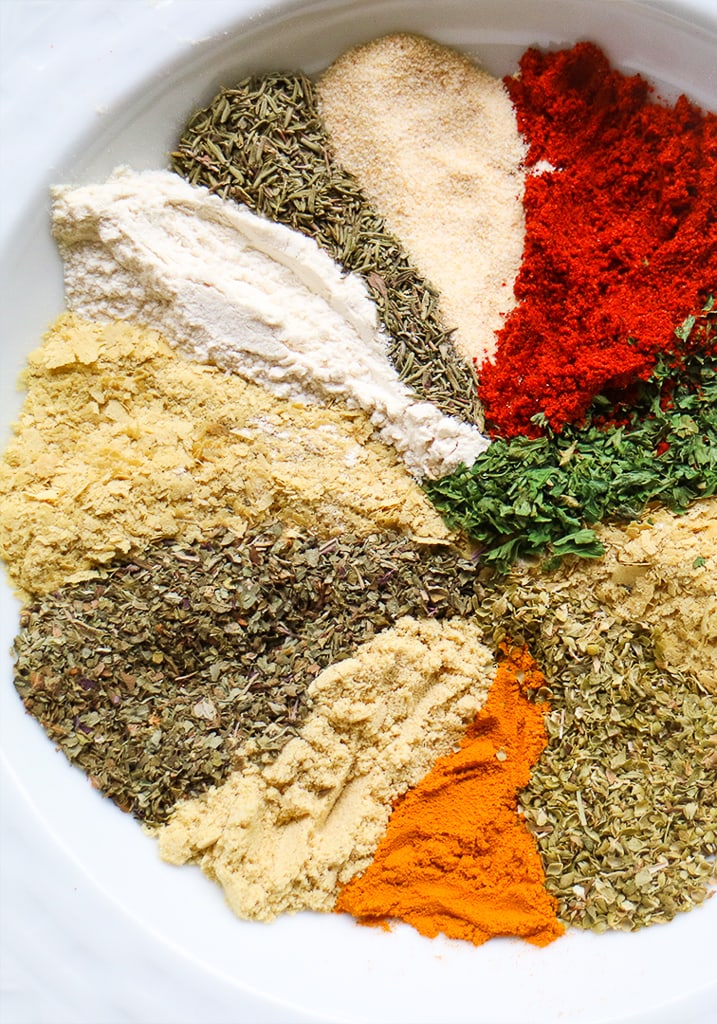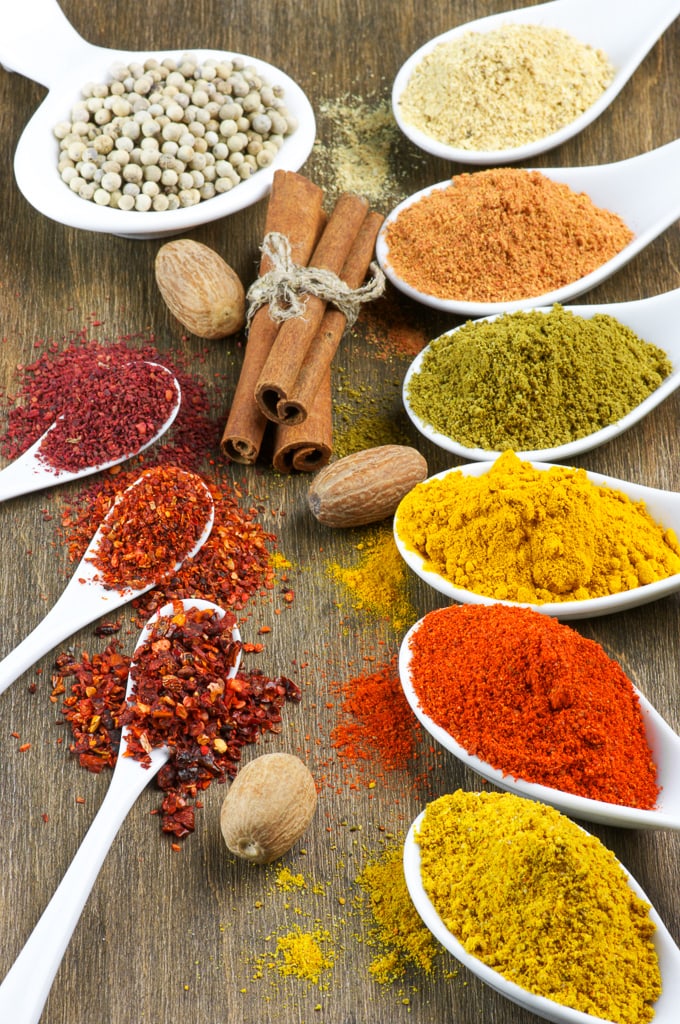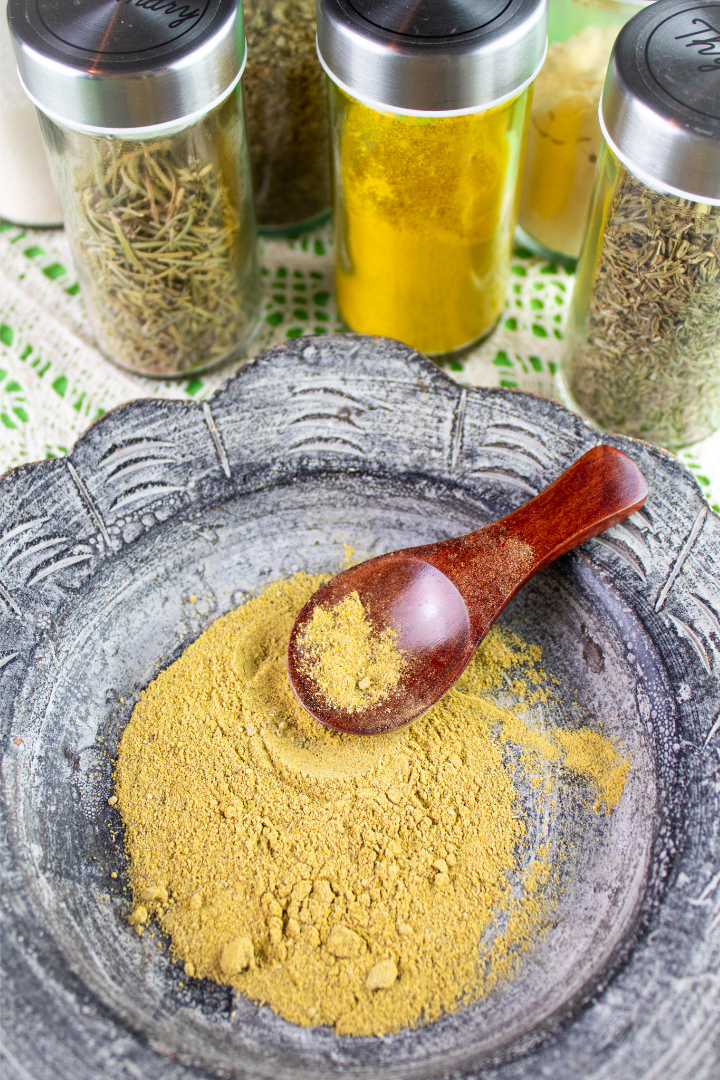Savory Spice Blend Seasoning (Salt-Free)
This simple and delicious Homemade Savory Spice Blend Seasoning is perfect for keeping on hand to add flavor to dishes in place of salt. It livens up even the blandest meals.

This amazing mixed spice blend was created by Dr. Michael Greger, MD with NutritionFacts.org. He has many more herb seasonings and recipes in his book, How Not to Die Cookbook. He has another delicious seasoning called Oil-Free Umami Sauce that is completely salt-free.
Making any recipe taste delicious is all about the seasonings, and this one is great for sprinkling over foods to add the perfect amount of flavor. A few more useful and fabulous herb seasonings are our Homemade Vegetable Bouillon Powder, my dairy-free ranch seasoning mix, and this Vegan Parmesan.
If you are new to cooking or just plant-based cooking in general this list of Top 15 Herbs & Spices can help get you on the right track.
What is a savory spice blend?
The word savory is a bit complicated because it is overly used in the cooking community and yes, I’m guilty of it too. It basically means food that is seasoned to be full of flavor but not sweet. I think of savory as being the opposite of sweet as with dishes like meatless chili, pizza, vegan mushroom stroganoff, dairy-free mashed potatoes, easy vegan gravy, etc.
In this spice blend, there is a mix of 10 herbs and spices that pair well with any savory dish.
Ingredients you will need

Most of the spices used in this blend are probably already in your cupboard because they are so common and widely used.
- Nutritional yeast– This a deactivated yeast with a cheesy, nutty flavor that’s commonly used in vegan cooking to add a savory, umami taste, as well as being rich in vitamins, especially B12.
- Onion powder- Finely ground, dehydrated form of onion that adds a sweet, savory flavor to dishes, offering a convenient way to enhance the taste of soups, sauces, and seasonings.
- Parsley- Dried and finely crushed form of parsley that adds a mild, fresh, and slightly peppery flavor to dishes, often used as a seasoning or garnish in soups, sauces, and marinades.
- Basil- A fragrant herb with sweet, slightly peppery notes, commonly used in Mediterranean and Asian cuisines to enhance the flavor of sauces, salads, and pesto.
- Thyme- Has earthy, slightly minty, and lemony flavors, and is often used to season soups, stews, vegetables, and marinades in various cuisines.
- Garlic powder- A ground, dehydrated form of garlic that adds a concentrated, savory flavor to dishes, making it a convenient seasoning for a variety of recipes.
- Ground mustard- Powdered form of mustard seeds that adds a sharp, tangy, and slightly spicy flavor to sauces, dressings, and seasonings.
- Paprika- A vibrant red spice made from ground dried peppers, offering a sweet, mild flavor with varying levels of heat, commonly used to season and color dishes in many cuisines.
- Turmeric- This is a bright yellow spice derived from the root of the Curcuma longa plant, known for its earthy flavor and powerful anti-inflammatory properties, often used in curries and as a natural coloring agent.
- Celery seeds- Small, aromatic seeds from the celery plant that impart a distinct, slightly bitter flavor, commonly used as a seasoning in salads, soups, and pickling.
Tips & Suggestions
- Uses- Sprinkle over any savory recipe or dish in place of salt.
- Store- Keep this spice blend in an airtight container or jar and store in a cool, dry place. Does not require refrigeration.
- Nutritional yeast- Dr. Greger recommends those with Crohn’s disease or hidradenitis suppurativa avoid nutritional yeast.
How to make savory seasoning
The recipe card at the bottom of the page has the full list of ingredients with measurements and instructions.
STEP #1: Make sure that all of the ingredients to be used are the dried versions. An example of this is dried parsley flakes and not fresh parsley.
STEP #2: Combine all of the ingredients in a spice grinder or blender and pulverize the dried herbs and spices.
STEP #3: Transfer the blend into a shaker bottle or jar with a tight-fitting lid. I personally like this spice shaker by OXO because the lid has two settings for coarse and fine, and it twists shut to seal for freshness. Store in a cool, dry place.
STEP #4: This savory spice blend can be sprinkled generously over oil-free roasted vegetables, added to soups and stews, or mixed into grain dishes like quinoa or rice to enhance their flavor. It also works wonderfully as a seasoning for plant-based proteins like tofu or tempeh, elevating any dish with its aromatic, robust taste.
Excerpted from the HOW NOT TO DIE COOKBOOK by Michael Greger, M.D. with Gene Stone. Copyright © 2017 by Michael Greger with Gene Stone. Reprinted with permission from Flatiron Books. All rights reserved. Recipes by Robin Robertson. Photography by Antonis Achilleos.
Recipes that could use a little Savory Seasoning
Frequently Asked Questions
Absolutely! Feel free to adjust the proportions or add different spices and herbs according to your taste preferences, such as adding cumin for warmth or chili powder for heat.
You can use the savory spice blend to season roasted vegetables, soups, stews, grains, or plant-based proteins like tofu and tempeh. It’s versatile and can be added to almost any dish for extra flavor.
Yes, a homemade savory spice blend is typically vegan, gluten-free, and free from preservatives, making it suitable for various dietary needs.
Store your homemade savory spice blend in an airtight container in a cool, dark place, such as a pantry or cupboard, where it can last for up to 6 months.

For those of you new to the whole food plant-based lifestyle, we’ve created a FREE 7-Day Plant-Based Menu Planner to help you get started!
If you try this recipe, please let us know how you like it by rating it and leaving a comment. We love to hear from you!
Want to Save This Recipe?
Enter your email & I’ll send it to your inbox. Plus, get great new recipes from me every week!
By submitting this form, you consent to receive emails from EatPlant-Based

Savory Spice Blend Seasoning
Ingredients
- 2 tablespoons nutritional yeast
- 1 tablespoon onion powder
- 2 teaspoons garlic powder
- 1 tablespoon dried parsley
- 1 tablespoon dried basil
- 2 teaspoons dried thyme
- 2 teaspoons dry mustard mustard powder
- 2 teaspoons paprika
- 1/2 teaspoon ground turmeric
- 1/2 teaspoon celery seeds
Instructions
- First, make sure that all of the ingredients to be used are the dried versions. An example of this is dried parsley flakes and not fresh parsley.
- Combine all of the ingredients in a spice grinder or blender and pulverize the dried herbs and spices.
- Recipe makes 1/2 cup which is 24 teaspoons.
- Transfer the blend into a shaker bottle or jar with a tight-fitting lid. I personally like this spice shaker by OXO because the lid has two settings for coarse and fine, and it twists shut to seal for freshness. Store in a cool, dry place.
- This savory spice blend can be sprinkled generously over oil-free roasted vegetables, added to soups and stews, or mixed into grain dishes like quinoa or rice to enhance their flavor. It also works wonderfully as a seasoning for plant-based proteins like tofu or tempeh, elevating any dish with its aromatic, robust taste.
Video
Notes
- Uses- Sprinkle over any savory recipe or dish in place of salt.
- Store- Keep this spice blend in an airtight container or jar and store in a cool, dry place. Does not require refrigeration.
- Nutritional yeast- Dr. Greger recommends those with Crohn’s disease or hidradenitis suppurativa avoid nutritional yeast
Nutrition
Disclaimer
To obtain the most accurate representation of the nutritional information in a given recipe, you should calculate the nutritional information with the actual ingredients used in your recipe, using your preferred nutrition calculator. You are solely responsible for ensuring that any nutritional information provided is accurate, complete, and useful.
About the Chef
Dr. Greger is a physician, New York Times bestselling author, and internationally recognized speaker on nutrition, food safety, and public health issues. He is the Research Director for NutritionFacts.org.
A founding member and Fellow of the American College of Lifestyle Medicine, Dr. Greger is licensed as a general practitioner specializing in clinical nutrition.
He is a graduate of the Cornell University School of Agriculture and Tufts University School of Medicine. In 2017, Dr. Greger was honored with the ACLM Lifestyle Medicine Trailblazer Award and became a diplomat of the American Board of Lifestyle Medicine.











How can I purchase the Savory Spice Blend Seasoning (Salt Free) ?
Hi Louise- This is actually a recipe to make the savory spice blend seasoning at home. It’s really easy and doesn’t call for salt as an ingredient.
been using this spice blend for years. It’s wonderful, especially like it in gravy.